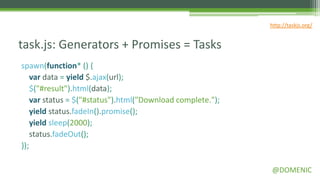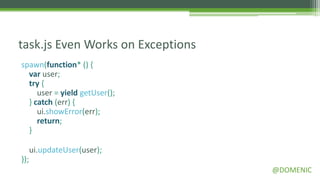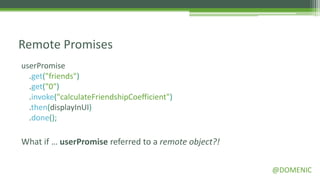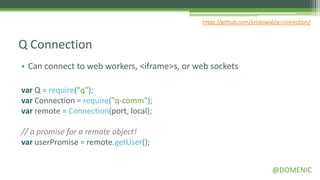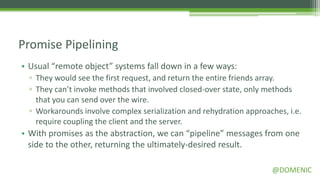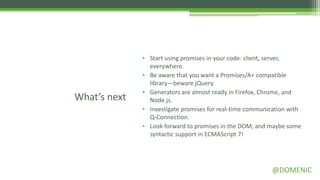Promises, Promises
- 1. Promises, Promises BY @DOMENIC
- 2. Domenic Denicola • http://domenic.me • https://github.com/domenic • https://npmjs.org/~domenic • http://slideshare.net/domenicdenicola Things I’m doing: • @esdiscuss on Twitter • The Promises/A+ spec • HTML5DevConf, NodePDX, NodeConf @DOMENIC
- 3. @DOMENIC
- 4. Callbacks are a hack • They are literally the simplest thing that could work. • But as a replacement for synchronous control flow, they suck. • There’s no consistency in callback APIs. • There’s no guarantees. • We lose the flow of our code writing callbacks that tie together other callbacks. • We lose the stack-unwinding semantics of exceptions, forcing us to handle errors explicitly at every step. @DOMENIC
- 5. Promises are the right abstraction Instead of calling a passed callback, return a promise: readFile("file.txt", function (err, result) { // continue here… }); // becomes var promiseForResult = readFile("file.txt"); @DOMENIC
- 6. Promise guarantees promiseForResult.then(onFulfilled, onRejected); • Only one of onFulfilled or onRejected will be called. • onFulfilled will be called with a single fulfillment value (⇔ return value). • onRejected will be called with a single rejection reason (⇔ thrown exception). • If the promise is already settled, the handlers will still be called once you attach them. • The handlers will always be called asynchronously. @DOMENIC
- 7. Promises can be chained var transformedPromise = originalPromise.then(onFulfilled, onRejected); • If the called handler returns a value, transformedPromise will be resolved with that value: ▫ If the returned value is a promise, we adopt its state. ▫ Otherwise, transformedPromise is fulfilled with that value. • If the called handler throws an exception, transformedPromise will be rejected with that exception. @DOMENIC
- 8. The Sync ⇔ Async Parallel var result, threw = false; try { result = doSomethingSync(); doSomethingAsync().then( } catch (ex) { process, threw = true; handle handle(ex); ); } if (!threw) process(result); @DOMENIC
- 9. Case 1: Simple Functional Transform var user = getUser(); var userName = user.name; // becomes var userNamePromise = getUser().then(function (user) { return user.name; }); @DOMENIC
- 10. Case 2: Reacting with an Exception var user = getUser(); if (user === null) throw new Error("null user!"); becomes var userPromise = getUser().then(function (user) { if (user === null) throw new Error("null user!"); return user; }); @DOMENIC
- 11. Case 3: Handling an Exception try { updateUser(data); } catch (ex) { console.log("There was an error:", ex); } // becomes var updatePromise = updateUser(data).then(undefined, function (ex) { console.log("There was an error:", ex); }); @DOMENIC
- 12. Case 4: Rethrowing an Exception try { updateUser(data); } catch (ex) { throw new Error("Updating user failed. Details: " + ex.message); } // becomes var updatePromise = updateUser(data).then(undefined, function (ex) { throw new Error("Updating user failed. Details: " + ex.message); }); @DOMENIC
- 13. Bonus Async Case: Waiting var name = promptForNewUserName(); updateUser({ name: name }); refreshUI(); // becomes promptForNewUserName() .then(function (name) { return updateUser({ name: name }); }) .then(refreshUI); @DOMENIC
- 14. Promises Give You Back Exception Propagation getUser("Domenic", function (user) { getBestFriend(user, function (friend) { ui.showBestFriend(friend); }); }); @DOMENIC
- 15. Promises Give You Back Exception Propagation getUser("Domenic", function (err, user) { if (err) { ui.error(err); } else { getBestFriend(user, function (err, friend) { if (err) { ui.error(err); } else { ui.showBestFriend(friend); } }); } }); @DOMENIC
- 16. Promises Give You Back Exception Propagation getUser("Domenic") .then(getBestFriend) .then(ui.showBestFriend, ui.error); @DOMENIC
- 17. Promises as First-Class Objects • Because promises are first-class objects, you can build simple operations on them instead of tying callbacks together: // Fulfills with an array of results, or rejects if any reject all([getUserData(), getCompanyData()]); // Fulfills as soon as either completes, or rejects if both reject any([storeDataOnServer1(), storeDataOnServer2()]); // If writeFile accepts promises as arguments, and readFile returns one: writeFile("dest.txt", readFile("source.txt")); @DOMENIC
- 18. @DOMENIC
- 19. Prehistory • “Discovered” circa 1989. • Much of modern promises are inspired by the E programming language. • They’ve made their way into many languages: ▫ .NET’s Task<T> ▫ java.util.concurrent.Future ▫ Python’s PEP 3148 ▫ C++ 11’s std::future @DOMENIC
- 20. CommonJS Promises/A • Inspired by early implementations: ref_send, Dojo, … • But… ▫ Underspecified ▫ Missing key features ▫ Often misinterpreted @DOMENIC
- 21. $.Deferred jQuery’s $.Deferred is a very buggy attempted implementation, that entirely misses the sync ⇔ async parallel: • Multiple fulfillment values and rejection reasons • Only supports scenario 1 (functional transformation); doesn’t handle errors • Not interoperable with other “thenables.” • Before 1.8, did not support returning a promise @DOMENIC
- 22. All Was Quiet, Until… HORRIBLE LIES!! @DOMENIC
- 23. I Got Angry @DOMENIC
- 24. Then I Did Something About It @DOMENIC
- 25. @DOMENIC
- 26. Then Things Got Awesome @DOMENIC
- 27. Fast-Forward a Few Months… @DOMENIC
- 28. I Think It’s Been a Success • >20 conformant implementations, with more showing up constantly ▫ Even one in ActionScript 3! • The creation of RSVP.js specifically so that Ember could have Promises/A+ compatible promises • Version 1.1 of the spec almost ready, nailing down some unspecified points • Several other sibling specs under active development: promise creation, cancellation, progress, … @DOMENIC
- 29. Even the DOM and TC39 are getting in on this • Alex Russell’s DOMFuture promise library, for possibly using promises in future or existing DOM APIs • Convergence with Mark Miller’s concurrency strawman, for integrating promises into the language @DOMENIC
- 30. Some practical guidance @DOMENIC
- 31. First, Choose a Library • My top picks: ▫ Q, by Kris Kowal and myself: https://github.com/kriskowal/q ▫ When.js, by Brian Cavalier: https://github.com/cujojs/when ▫ RSVP.js, by Yehuda Katz: https://github.com/tildeio/rsvp.js • If you ever see a jQuery promise, kill it with fire: var realPromise = Q(jQueryPromise); var realPromise = when(jQueryPromise); @DOMENIC
- 32. Keep The Sync ⇔ Async Parallel In Mind • Use promises for single operations that can result in fulfillment (⇔ returning a value) or rejection (⇔ throwing an exception). • If you’re ever stuck, ask “how would I structure this code if it were synchronous?” ▫ The only exception is multiple parallel operations, which has no sync counterpart. @DOMENIC
- 33. Promises Are Not • A replacement for events • A replacement for streams • A way of doing functional reactive programming They work together: • An event can trigger from one part of your UI, causing the event handler to trigger a promise-returning function • A HTTP request function can return a promise for a stream @DOMENIC
- 34. The Unhandled Rejection Pitfall This hits the top of the stack: throw new Error("boo!"); This stays inert: var promise = doSomething().then(function () { throw new Error("boo!"); }); @DOMENIC
- 35. Avoiding the Unhandled Rejection Pitfall • Always either: ▫ return the promise to your caller; ▫ or call .done() on it to signal that any unhandled rejections should explode function getUserName() { return getUser().then(function (user) { return user.name; }); } getUserName().then(function (userName) { console.log("User name: ", userName); }).done(); @DOMENIC
- 36. Promise Patterns: try/catch/finally ui.startSpinner(); getUser("Domenic") .then(getBestFriend) .then(ui.showBestFriend) .catch(ui.error) .finally(ui.stopSpinner) .done(); @DOMENIC
- 37. Promise Patterns: all + spread Q.all([getUser(), getCompany()]).then(function (results) { console.log("user = ", results[0]); console.log("company = ", results[1]); }).done(); Q.all([getUser(), getCompany()]).spread(function (user, company) { console.log("user = ", user); console.log("company = ", company); }).done(); @DOMENIC
- 38. Promise Patterns: map + all var userIds = ["123", "456", "789"]; Q.all(userIds.map(getUserById)) .then(function (users) { console.log("all the users: ", users); }) .done(); @DOMENIC
- 39. Promise Patterns: message sending var userData = getUserData(); userData .then(createUserViewModel) .invoke("setStatus", "loaded") .done(); userData .get("friends") .get("0") .get("name") .then(setBestFriendsNameInUI) .done(); @DOMENIC
- 40. Promise Patterns: Denodeify var readFile = Q.denodeify(fs.readFile); var readDir = Q.denodeify(fs.readdir); readDir("/tmp") .get("0") .then(readFile) .then(function (data) { console.log("The first temporary file contains: ", data); }) .catch(function (error) { console.log("One of the steps failed: ", error); }) .done(); @DOMENIC
- 41. (Bonus round!) @DOMENIC
- 42. Coroutines “Coroutines are computer program components that generalize subroutines to allow multiple entry points for suspending and resuming execution at certain locations.” @DOMENIC
- 43. Generators = Shallow Coroutines function* fibonacci() { var [prev, curr] = [0, 1]; while (true) { [prev, curr] = [curr, prev + curr]; yield curr; } } for (n of fibonnaci()) { console.log(n); } @DOMENIC
- 44. http://taskjs.org/ task.js: Generators + Promises = Tasks spawn(function* () { var data = yield $.ajax(url); $("#result").html(data); var status = $("#status").html("Download complete."); yield status.fadeIn().promise(); yield sleep(2000); status.fadeOut(); }); @DOMENIC
- 45. task.js Even Works on Exceptions spawn(function* () { var user; try { user = yield getUser(); } catch (err) { ui.showError(err); return; } ui.updateUser(user); }); @DOMENIC
- 46. Remote Promises userPromise .get("friends") .get("0") .invoke("calculateFriendshipCoefficient") .then(displayInUI) .done(); What if … userPromise referred to a remote object?! @DOMENIC
- 47. https://github.com/kriskowal/q-connection/ Q Connection • Can connect to web workers, <iframe>s, or web sockets var Q = require("q"); var Connection = require("q-comm"); var remote = Connection(port, local); // a promise for a remote object! var userPromise = remote.getUser(); @DOMENIC
- 48. Promise Pipelining • Usual “remote object” systems fall down in a few ways: ▫ They would see the first request, and return the entire friends array. ▫ They can’t invoke methods that involved closed-over state, only methods that you can send over the wire. ▫ Workarounds involve complex serialization and rehydration approaches, i.e. require coupling the client and the server. • With promises as the abstraction, we can “pipeline” messages from one side to the other, returning the ultimately-desired result. @DOMENIC
- 49. • Start using promises in your code: client, server, everywhere. • Be aware that you want a Promises/A+ compatible library—beware jQuery. • Generators are almost ready in Firefox, Chrome, and What’s next Node.js. • Investigate promises for real-time communication with Q-Connection. • Look forward to promises in the DOM, and maybe some syntactic support in ECMAScript 7! @DOMENIC
Editor's Notes
- #2: Hook: how many used promises?jQuery promises or real promises?Want to talk about this in three parts: a ground-up view of the promise abstraction; a historical perspective on recent developments; and a practical guide to using them in your code.
- #5: What I really mean by this is “callback-accepting functions are a hack.”
- #6: First benefit: separating outputs from inputs.
- #7: - Consistency gains: never call back with more than one fulfillment value or rejection reason.
- #8: Just like a series of imperative statements.
- #22: And yet, we lived with it.
- #28: Spec development process through GitHub issue trackerPull requests, implementers weighing in, bugs opened by randoms, etc.Test suite!
- #32: Q has:Large, powerful API surfaceAdapters for Node.jsProgress supportSome support for long stack traces





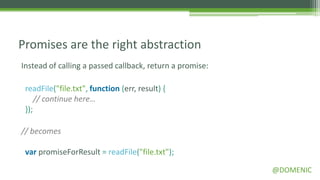
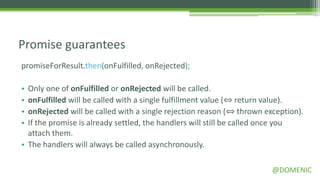
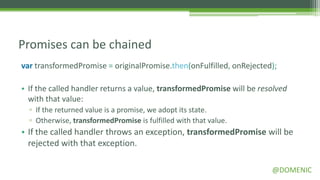
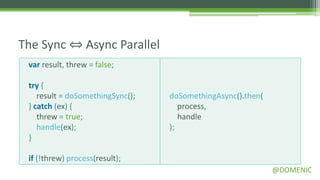
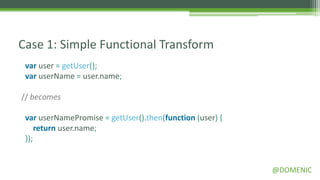
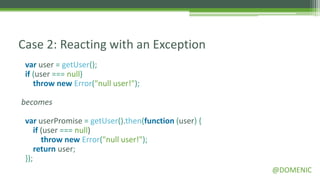
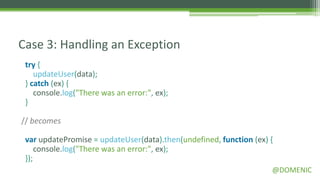
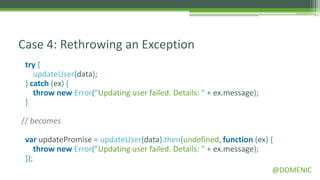
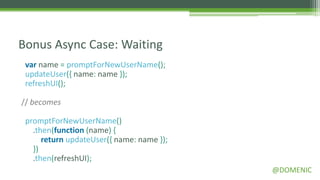
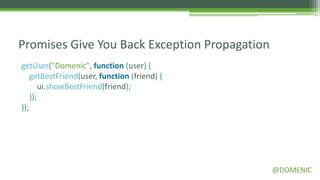
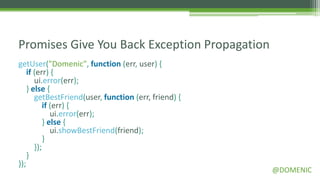
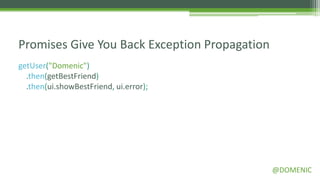
![Promises as First-Class Objects
• Because promises are first-class objects, you can build simple operations on
them instead of tying callbacks together:
// Fulfills with an array of results, or rejects if any reject
all([getUserData(), getCompanyData()]);
// Fulfills as soon as either completes, or rejects if both reject
any([storeDataOnServer1(), storeDataOnServer2()]);
// If writeFile accepts promises as arguments, and readFile returns one:
writeFile("dest.txt", readFile("source.txt"));
@DOMENIC](https://image.slidesharecdn.com/promisespromises-130323223117-phpapp02/85/Promises-Promises-17-320.jpg)

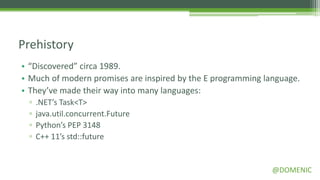
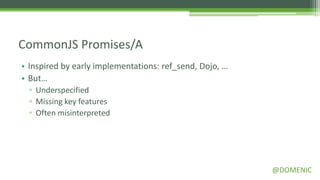
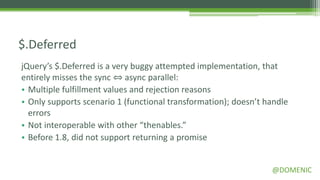
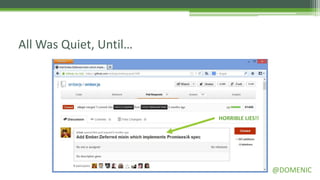
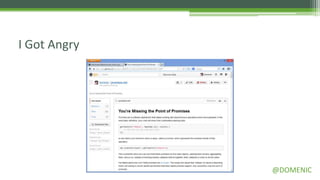
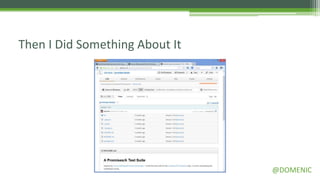
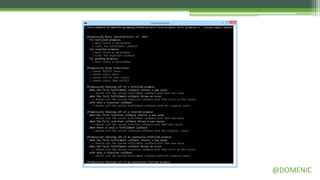

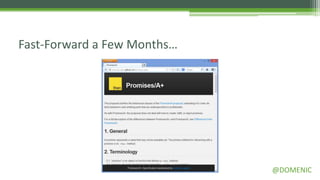
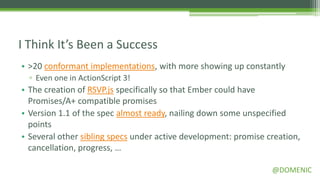
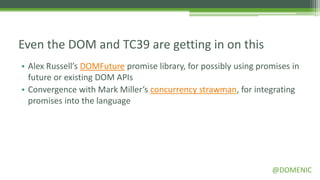
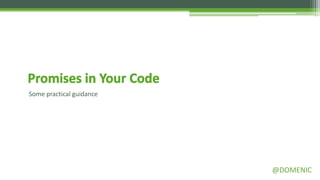
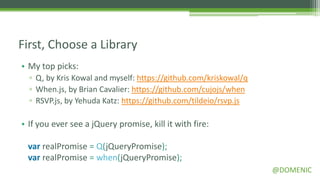

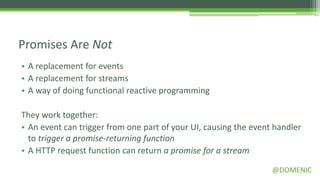
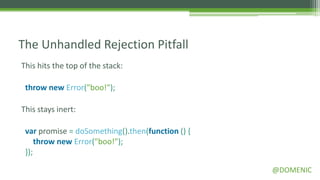
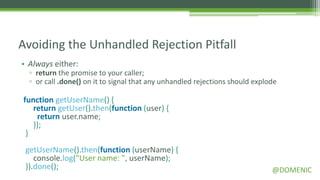
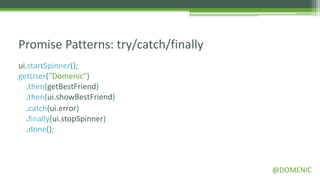
![Promise Patterns: all + spread
Q.all([getUser(), getCompany()]).then(function (results) {
console.log("user = ", results[0]);
console.log("company = ", results[1]);
}).done();
Q.all([getUser(), getCompany()]).spread(function (user, company) {
console.log("user = ", user);
console.log("company = ", company);
}).done();
@DOMENIC](https://image.slidesharecdn.com/promisespromises-130323223117-phpapp02/85/Promises-Promises-37-320.jpg)
![Promise Patterns: map + all
var userIds = ["123", "456", "789"];
Q.all(userIds.map(getUserById))
.then(function (users) {
console.log("all the users: ", users);
})
.done();
@DOMENIC](https://image.slidesharecdn.com/promisespromises-130323223117-phpapp02/85/Promises-Promises-38-320.jpg)
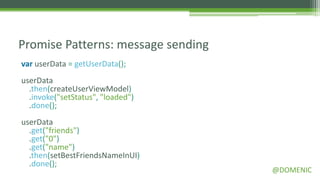
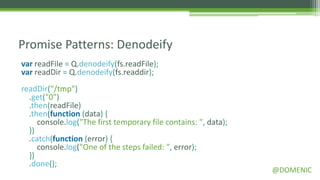

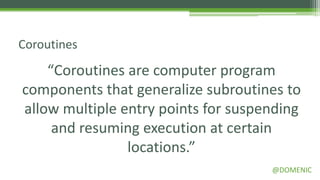
![Generators = Shallow Coroutines
function* fibonacci() {
var [prev, curr] = [0, 1];
while (true) {
[prev, curr] = [curr, prev + curr];
yield curr;
}
}
for (n of fibonnaci()) {
console.log(n);
} @DOMENIC](https://image.slidesharecdn.com/promisespromises-130323223117-phpapp02/85/Promises-Promises-43-320.jpg)
